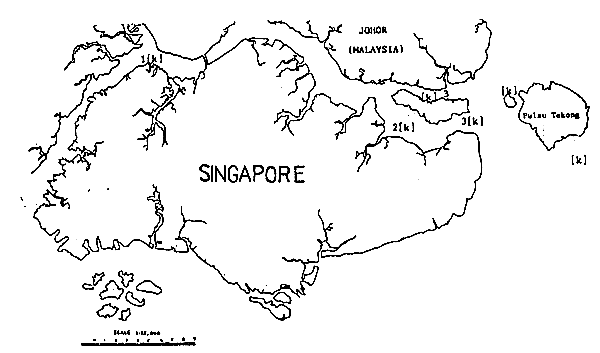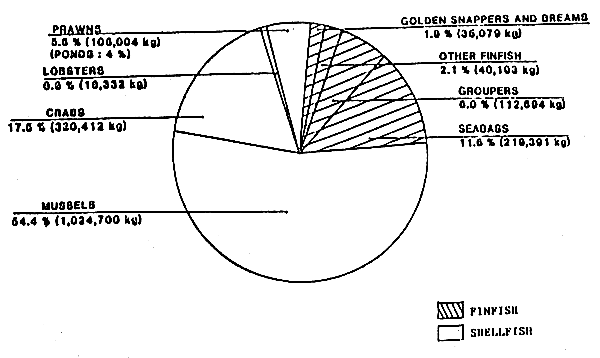1.1 The countries in Southeast Asia have been identified as one of the potential growth areas in aquaculture. These countries have a long history of fish farming and a generally high per capita fish consumption of at least 10 kg/annum and above. The waters are highly productive due to the warm tropical conditions.
1.2 Singapore's aquaculture possibly began in the early 1930s when the traditional Chinese system of polycarp culture and prawn trapping in brackish water impoundments were introduced in the Republic. However due to limited land and water resources in the Republic and the need to develop such resources for other national priorities, such as urbanisation, industrialisation, port development, housing and recreation, these traditional farms have slowly dwindled in numbers and only a handful of them remain today.
1.3 The Government started marine aquaculture studies in the late 1960s with the objective of producing prime quality fish through intensive culture. The early studies were on the culture of groupers (Epinephelus tauvina) in floating netcages off the coast. In the mid 1970s the culture of green mussels (Perna viridis) on ropes suspended from rafts was looked into. More recently, in March 1981, a marine fish farming scheme was implemented to encourage the people to start floating farms in designated coastal areas along Johore Straits - a waterway in the north separating Singapore from peninsular Malaysia.
1.4 To date (1988) there are 70 floating farms installed over a 37 ha water space (Fig I/1). Together with another 375 ha of brackish water ponds (Fig I/2) they produce slightly more than 1% or 1300 m tons (Fig I/3) of the overall 114,000 m tons of total fish availability in Singapore. Per capita fish consumption is close to 30 kg/annum. Besides groupers and green mussels, farmers also culture seabass (Lates calcarifer), golden snapper (Lutjanus johni), banana prawns (Penaeus merguiensis), mangrove crabs (Scylla serrata) and other assorted fish and shellfish.
2.1 Research on marine and brackish water aquaculture is conducted by the Marine Aquaculture Section of the Primary Production Department, Ministry of National Development. The main areas of research are in breeding, nutrition, disease and production. Studies are focussed on development of techniques which are applicable for intensive cultures, both on-shore and off-shore. In breeding studies, for example, the emphasis is not only on the development of techniques suitable for land-based hatcheries but also hatcheries in floating farms. Weaning studies under nutrition research have looked at weaning in tanks as well as in floating netcages. Disease work has largely concentrated on case studies encountered in floating farms. Under production research, intensive culture of prawns in netcages as well as raceways are being looked into. This dual approach is aimed at maximising utilisation of the scarce land and sea resources available for aquaculture.
2.2 Another feature of the research is the link-up with farmers on joint studies. This is considered essential in that, not only is there direct transfer of technology to the private sector through the results obtained, but also better rapport is developed between the researcher and the farmer thereby enhancing better feedback. An on-going project undertaken jointly between the Department and a commercial company is on intensive culture of fish and prawns in raceways under a water-recirculating system. Other joint projects include fish sanitisation trials, seabass feed trials and development of a floating prawn nursery.
3.1 The Government has identified aquaculture as a potential growth industry in Singapore, singling out, in particular, growth sectors such as development of intensive farming systems, hatchery technology and feed technology. The Government intends to attract agro-based companies to introduce new technology in these areas and others, and also to further develop technology for aquaculture in the tropics. It believes that Singapore can serve as an excellent Research and Development base for research into tropical aquaculture because of its geographical location and available infrastructure support for R & D. Farming companies can actively carry out R & D while the farms are in commercial production. The new findings will then be applied on a commercial farming scale so as to upgrade and improve production.
3.2 In this connection, the Government will set up agrotechnology parks over the next 5 years in various parts of the island for agriculture development. Total area devoted to these parks will be 2,000 ha with some 1,500 ha of usable farmland. The Government will provide roads, electricity and water supply to the farm lots which will vary in size from 2–5 ha. It is envisaged that there will be about 200–300 agricultural farms in all.

| LOCATION | NO. OF FARMS | % | |
| 1. | LIM CHU KANG COAST | 17 | 24 |
| 2. | SERANGOON | 11 | 16 |
| 3. | P.UBIN COAST | 27 | 39 |
| [K]. | FISH TRAP (KELONGS) SITES | 15 | 21 |
| TOTAL | 70 | 100 |
Figure I/1. Distribution of Marine Floating Fish Farms in Singapore (as at end 1987).

Figure I/2. Distribution of Brackishwater Fish Farms in Singapore (as at end 1987)

Figure I/3. Pie-Chart of Types of Fish Farmed in Brackish and Marine Waters in Singapore in Terms of Production (KG), Based on 1987 Production Data.